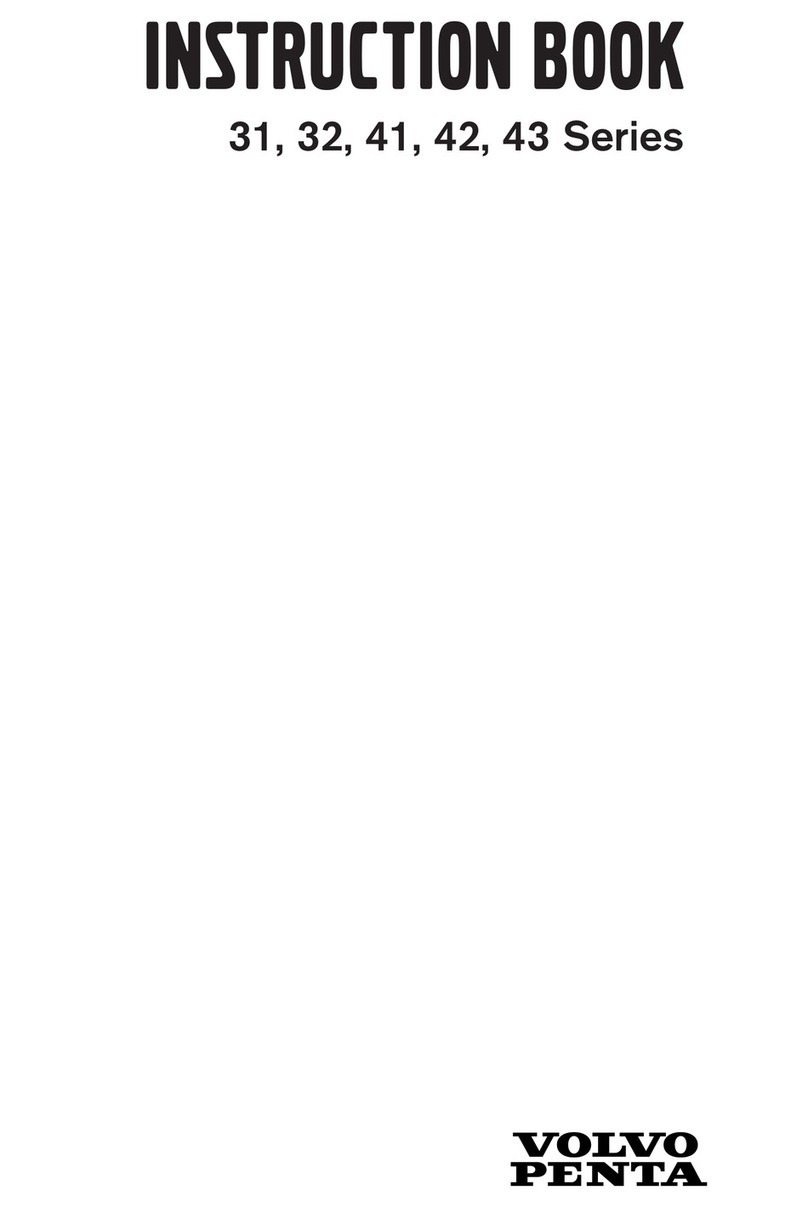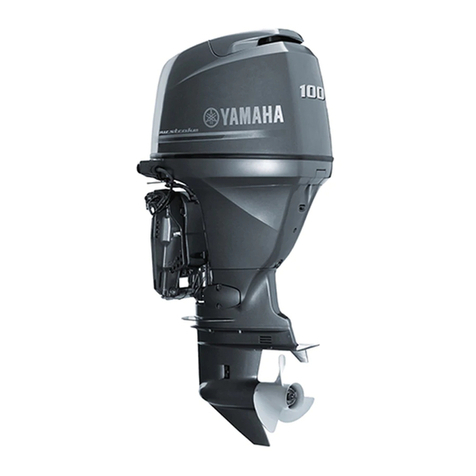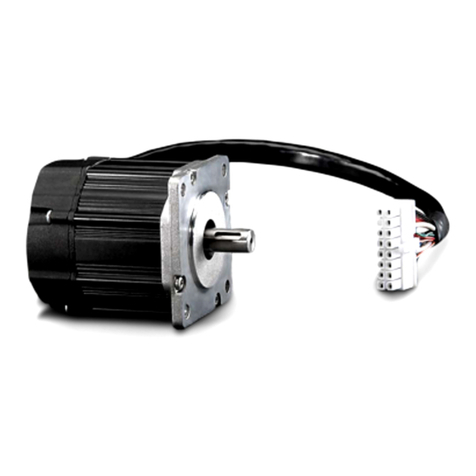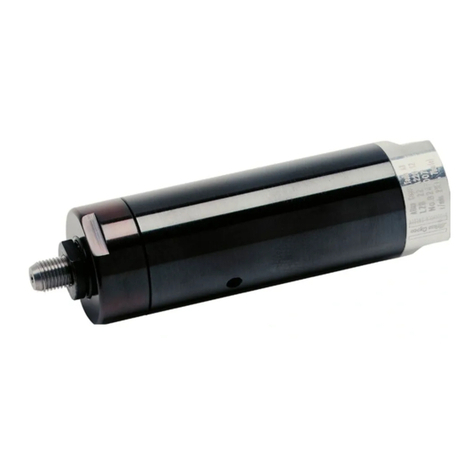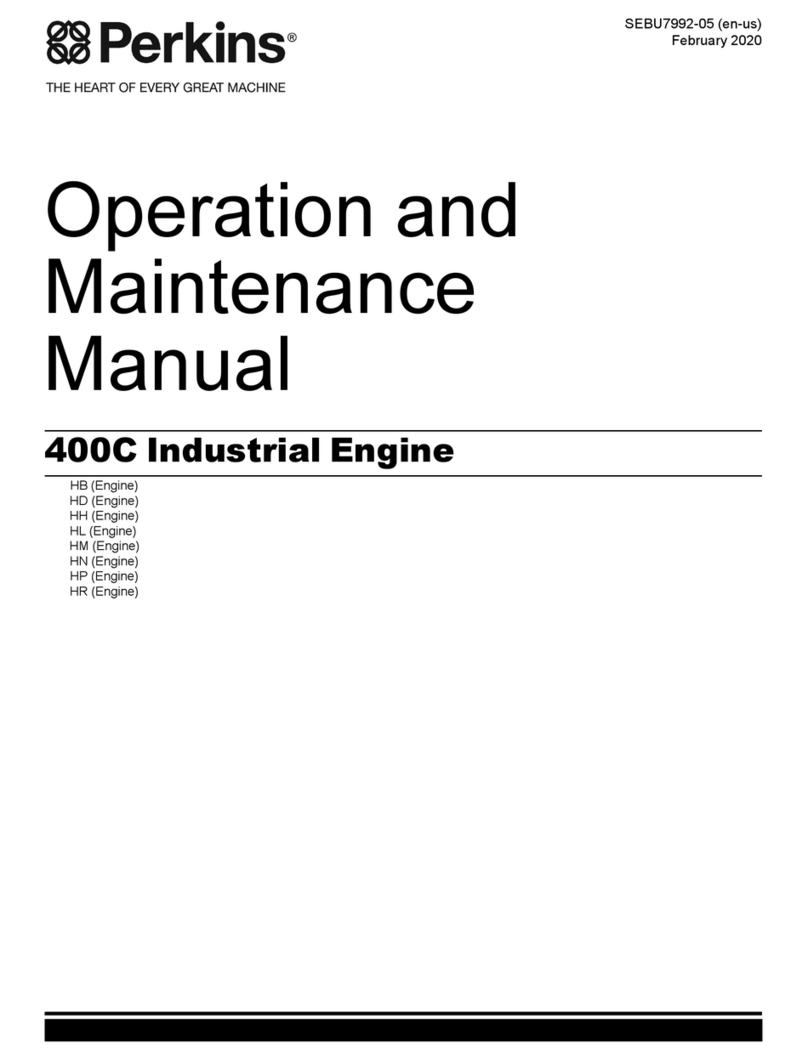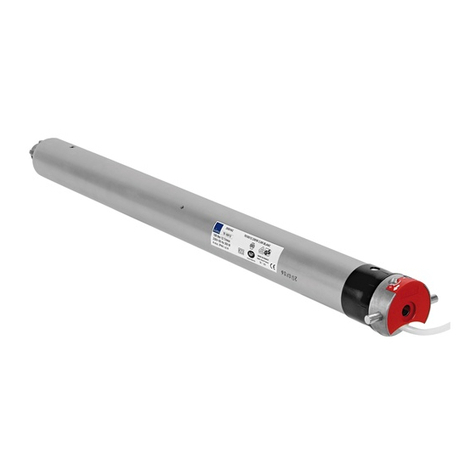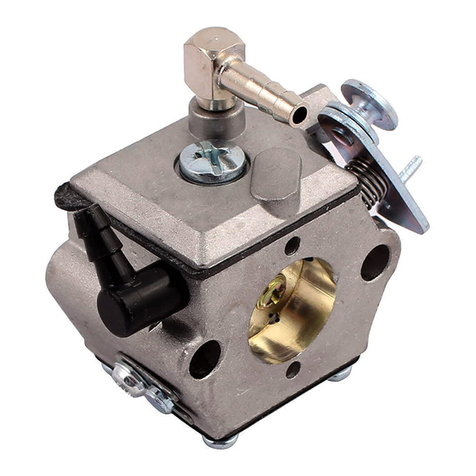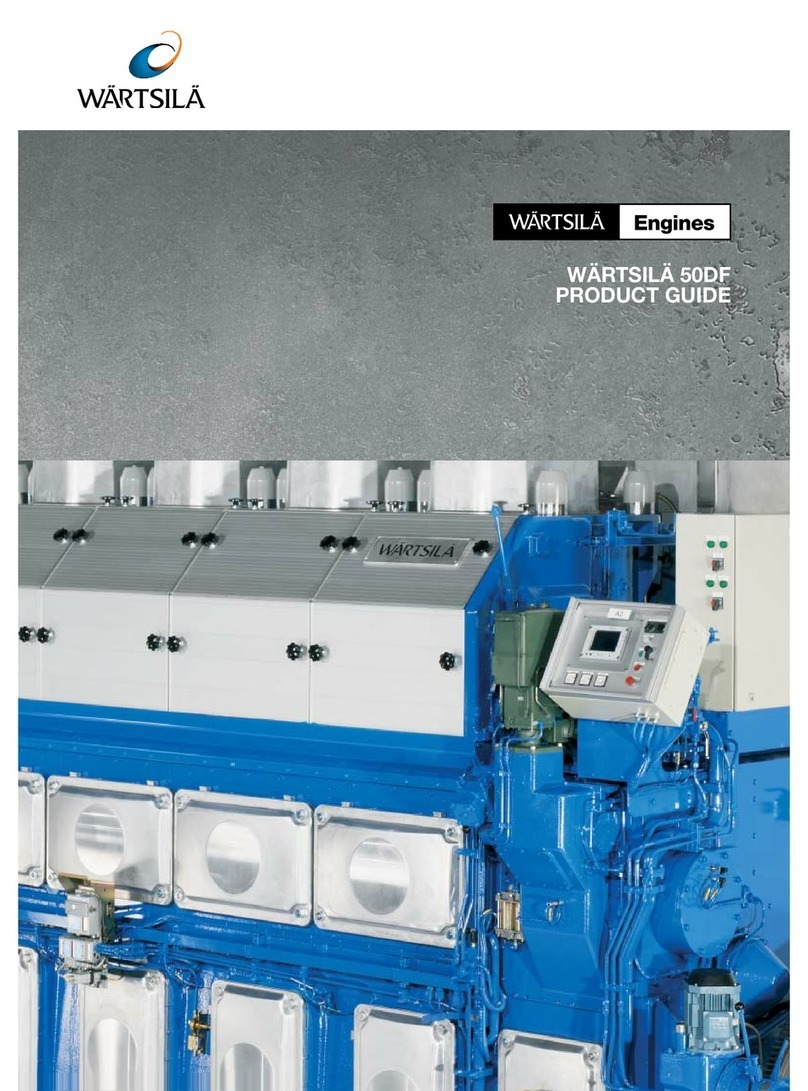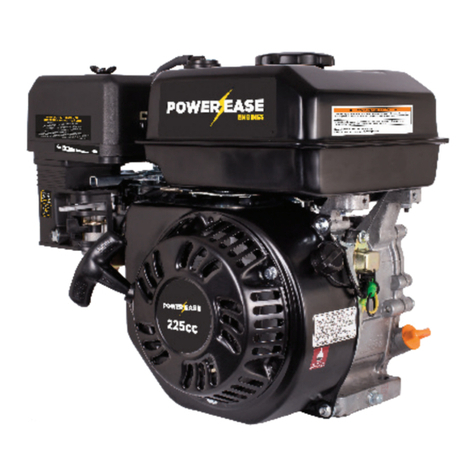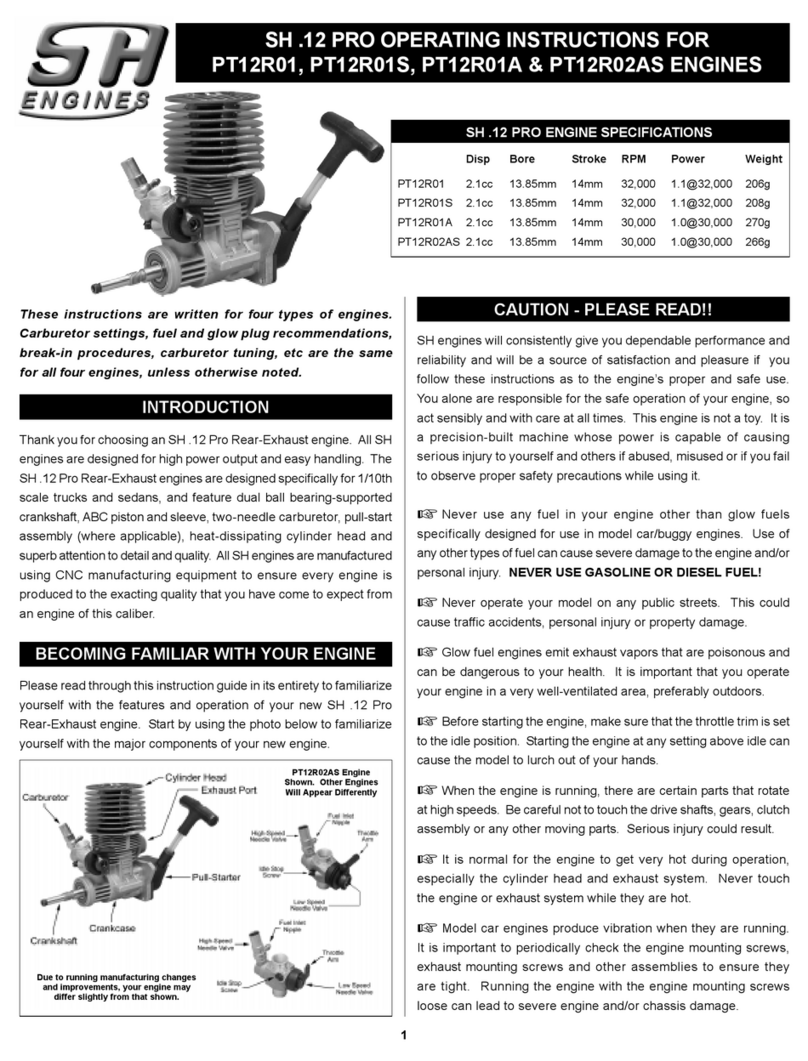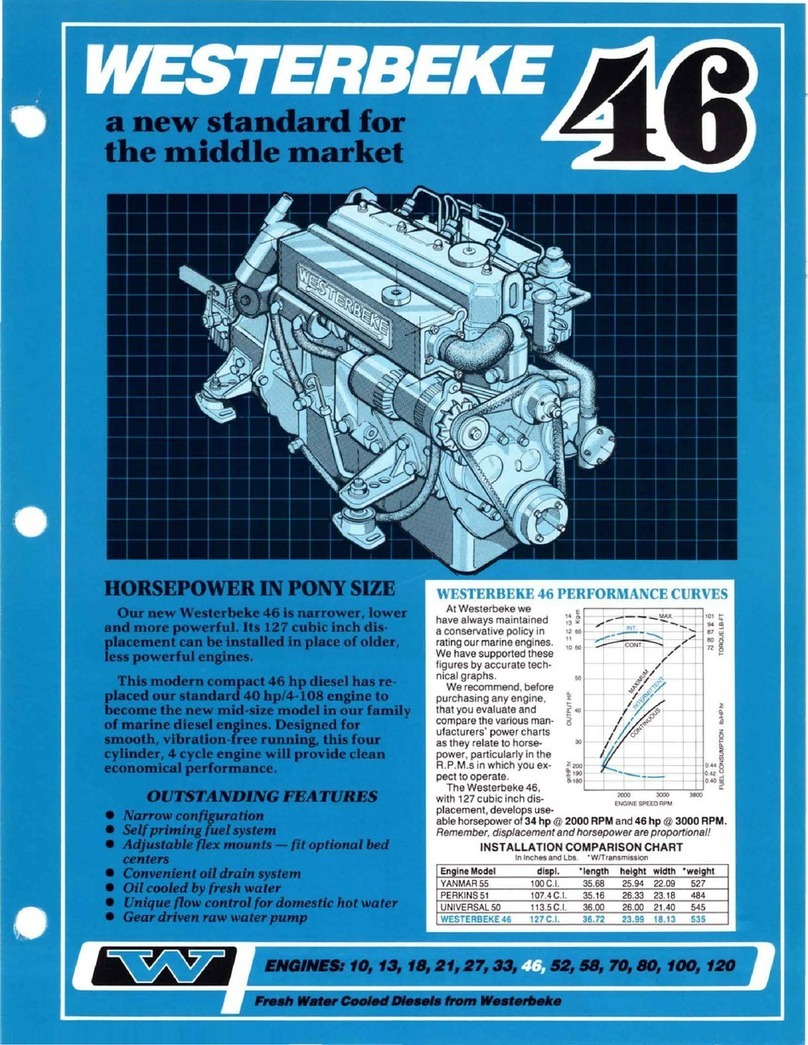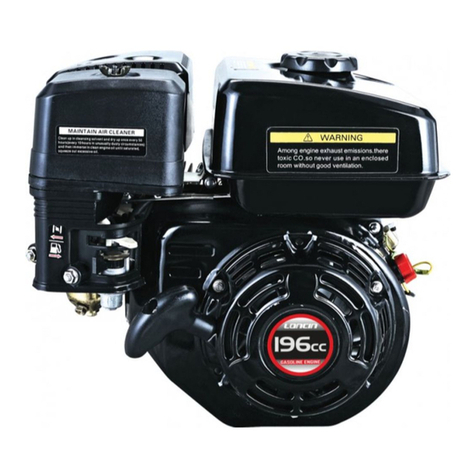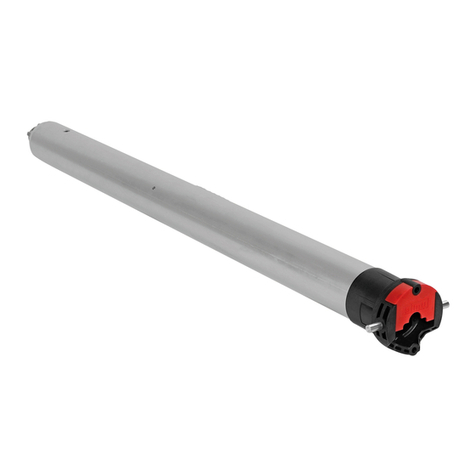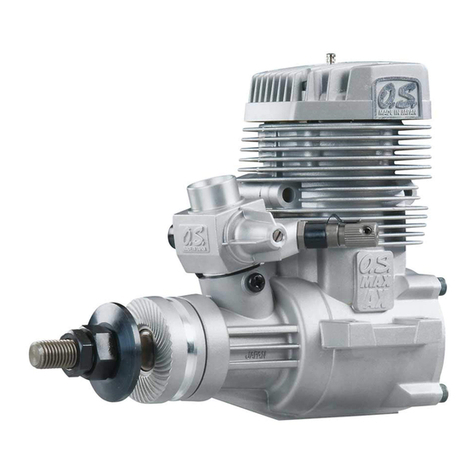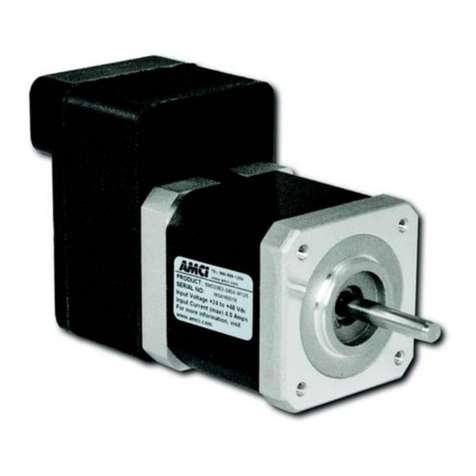HFE GENPOD 100 User manual

OWNER’S
MANUAL
HFE INTERNATIONAL
GENPOD®100
HFEDCN0543
Revision B

1
SPECIFICATIONS........................................2
SAFETY PRECAUTIONS ..............................4
FUEL REQUIREMENTS ...............................5
COMPONENT IDENTIFICATION..................6
INSTALLATION AND STARTING..................9
INSTALLATION.....................................................................................................9
THROTTLE, COMMUNICATION, AND ENABLE SETUP..........................................11
ENGINE STARTING.............................................................................................12
STARTING AGAIN AFTER FIRST START................................................................12
REMOVING THE ENGINE....................................................................................13
INTERFACE SPECIFICATIONS....................14
MAINTENANCE .......................................18
Torque Specifications........................................................................................18
Maintenance Schedule......................................................................................18
Fuel Filter Replacement.....................................................................................19
TROUBLESHOOTING................................21
MAX POWER WORKSHEET......................24
PARTS LIST..............................................27
WARRANTY.............................................28
Document Revision Table
Rev
Description of change
Revised by
Revision
Date
Approved By
Approved
Date
A
Initial Release
KGRATIEN
2021/03/11
DRB
2021/03/11
B
Revised Warm Up CHT
TWEST
2021/07/20
KGRATIEN
2021/07/20
CONTENTS

2
SPECIFICATIONS
Metric
Value (SI)
Value (SAE)
Actual displacement
100 cc
6.1 in3
Momentary Peak Power @ rated
RPM
6.1 kW @ 9000 RPM
8.2 hP @ 9000 RPM
Max Continuous Power
5.5 kW @ 7000 RPM
7.3 hP @ 7000 RPM
Peak Torque @ RPM
7.7 NM @ 6500 RPM
5.7 ft lbs @ 6500 RPM
Max Torsional Impulse
16 NM
11.8 ft lbs
Cruise BSFC @ RPM
564 g/kW-hr @ 6500 RPM
0.93 lb/hP-hr @ 6500 RPM
Idle BSFC @ RPM
708 g/kW-hr @ 3500 RPM
1.16 lb/hP-hr @ 3500 RPM
Do Not Exceed Max RPM
9000 RPM
9000 RPM
Rated (useable) Max RPM
7500 RPM
7500 RPM
Standard Operating RPM Range
2500 –7000 RPM
2500 -7000 RPM
Full System Weight with mufflers
5.54 kg
12.2 lb
Full System Power to Weight
Ratio
1.1 kW/kg
0.67 hp/lb.
Generator Operating RPM
3500 RPM to 8000 RPM
3500 RPM to 8000 RPM
Nominal Current Draw (12V)
0.5 A
0.5 A
Maximum Current Draw (12V)
1 A
1 A
Rated Max CHT
130 °C
270 °F
Do Not Exceed CHT
190 °C
375 °F
CHT after warm up
65 °C
150 °F
Rated Ambient Minimum
-18 °C
0 °F
Rated Ambient Maximum
49 °C
120 °F
Nominal Dynamic Compression
9 bar
130 psi
Compression Ratio
8.5 : 1
8.5 : 1
Time between overhauls
300 Hrs
300 Hrs
Sound Level
TBD
TBD

3

4
General Safety
Read and understand this Owner’s Manual before operating your engine. You can
help prevent accidents by being familiar with the controls and observing safe
operating procedures.
Operator’s Responsibility:
1. The operator should know how to stop the engine quickly in case of an emergency.
2. A safety zone of 3 feet around the propeller should be established in which no person
or object is allowed to enter. Install a guard around the propeller when appropriate.
WARNING
1. Observe all safety precautions when working around the propeller.
2. Exhaust contains poisonous carbon monoxide, a colorless and odorless gas.
Breathing carbon monoxide can cause loss of consciousness and may lead to death.
3. Never run your engine in an enclosed space. Always allow for appropriate
ventilation.
4. Observe precaution around the muffler. The exhaust system gets hot enough to
ignite some materials.
5. Keep flammable materials away from the engine.
6. Gasoline is extremely flammable and is explosive under certain conditions. Do not
smoke or allow flames or sparks where the engine is operating.
SAFETY
PRECAUTIONS

5
Engine Oil
This engine was calibrated using Red Line 2 Stroke Racing oil at a mix ratio of 40:1. This oil
type and mix ratio should be maintained to ensure that the fuel injection system and engine
operates as designed. If Redline oil is not available, use an equivalent 2T quality two stroke
oil for best results.
Oil Brand:
Red Line
Oil Type:
2 Stroke Racing Oil
Mix Ratio: 40:1
40 parts gasoline to one part oil by
volume.
Fuel Recommendations
The engine was calibrated with standard 87 octane gasoline. Customers may use higher
octane fuel if desired. Non-leaded fuels recommended.
Leaded Fuels Warning: When using leaded fuels, the result will be shorter TBO’s as a
result of lead oxide coking on cylinder and exhaust ports. Leaded fuels will require cylinder,
piston, and port, dressing and inspection every 50 to 100 hours (depending on use case).
Cylinder dressing and cleaning should be done by a trained professional or by HFE
International.
Note: Non-leaded fuels will not require cylinder dressing and may be used continuously until
the suggested TBO.
FUEL
REQUIREMENTS

6
Figure 1. GenPod® Connections and Components
Figure 2. GenPod®Air Filter
COMPONENT
IDENTIFICATION
Fuel Filter
Engine Connector
Generator
Connector
Fuel Connector
Air Filter
Display for
GenPod®
Status
Decompression
Valves

7
Figure 3. Intake Assembly Components
Figure 4: Intake Assembly Components
Throttle Servo
Injector
MAP Fitting
Fuel Fitting

8
Status
Display
Engine Hour Meter
Engine Speed (RPM)
Engine Status (Enabled /
Disabled)
Fault Codes will display in the
place of the standard display.
Faults:
CHT - Cylinder Head
Temperature Sensor Fault
MAT- Manifold air Temperature
Sensor Fault
TPS - No Throttle Command
given or throttle command error
Battery - Power to GenPod®is
too high or too low. See Signal
input limits.
RPM - Crank position sensor
error.
Pump - Fuel pressure problem
NOTE: display data will only show in CAN BUS communication mode

9
INSTALLATION
1. Install the GenPod®Interface to your aircraft with 4x M5 flat head screws, ensuring that
the attachment can handle up to 23 kg (50 lbs.) of thrust and vibration torque impulses
as high as 30 N-m (22 ft-lbs) to include a safety factor.
Figure 5. GenPod®Mounting Interface
INSTALLATION
AND STARTING
Permanently Install
GenPod®Mounting
Interface on Aircraft
with 4x M5 Flat Head
Screws
This Side Up
Allow 4 inches clearance or
more inside the vehicle for
wire strain relief

10
2. Verify that there is an opening in the center of the GenPod®Interface that allows for
the back-shell of the connectors and fuel line to fit once the engine is installed. Verify
that there are no sharp edges that the wire harness can chafe on and that the fuel line
cannot kink when engine is installed.
3. Connect main harness and PMU inside the aircraft. You may cut and adjust the
harness inside the aircraft as needed. Use Mil Spec connectors or similar.
4. Install Engine and fuel connector to the back of the GenPod®as shown.
5. The GenPod®uses a Sullivan PMU and alternator. Connect the Engine as shown in Error! R
eference source not found..
6. Install the GenPod®to the Interface by resting the pin in the interface hook and latching
the two latches on top. Secure the latch with M5 flat head screws before flight.
Figure 6: CAN BUS and Serial Switch

11
THROTTLE, COMMUNICATION, AND ENABLE SETUP
1. Throttle commands use a standard PWM signal. Expected pulse width range from 900µs
for closed throttle and 2100µs for wide open throttle.
2. To change between CAN BUS and Serial communication, slide the switch located on the
Genpod® cover towards the desired protocol (Figure 6).
3. (Throttle kill) When the pulse width from the receiver falls below 960µs (5% throttle),
the ECM will remove power to both the injector and ignition system thus stopping the
operation of the engine.
4. (Enable kill) Provide 5V power to the enable line, when power is removed ECM will
remove power to both the injector and ignition system thus stopping the operation of
the engine.
Figure 7. GenPod®Fuel Venting
Fuel Vent
Port

12
ENGINE STARTING
1. Verify that the throttle setting is at about 30%.
2. Prime your system for the first time by pressing and holding the fuel vent port when
the Genpod®power is on (Figure 7). Cycle the battery power to the Genpod®in 5
second intervals until fuel is flowing from the vent port without air. You should not
have to complete the priming process again unless the engine fuel system is allowed
to run dry or has been disconnected for any reason.
3. The engine should be started using an external hand held starter, or using a built-in
starting alternator. Flip starting is an additional option but is not
recommended due to possible injuries.
Note: The engine may struggle to run for the first few minutes as it is purging all the
air from the fuel system. This may not be evident until you go to wide open throttle.
4. Allow the engine to run for a few minutes around 3500 RPM.
5. Keep at wide open throttle for 10 seconds to verify that the air in the fuel system has
been purged. Reduce the engine speed to idle.
STARTING AGAIN AFTER FIRST START
1. Verify that the throttle setting is at about 30%.
2. The engine should be started using an external hand held starter, or using a built-in
starting alternator. Flip starting is an additional option but is not
recommended due to possible injuries.
3. Allow the engine to run for a few minutes around 3500 RPM.
4. Keep at wide open throttle for 10 seconds to verify that the air in the fuel system has
been purged. Reduce the engine speed to idle.

13
Figure 8: Genpod® Buttons
REMOVING THE ENGINE
1. Remove the M5 flat head screws securing the Genpod®to the latches.
2. Press the buttons as seen in Figure 8 to lift the latches up. While supporting the
Genpod®, lean the Genpod®forward.
3. Disconnect the main harness, the PMU harness, and the fuel connector from the
Genpod®.
4. Lift and remove the Genpod®. If the Genpod® is to be shipped, please use the HFE Int.
provided packaging.

14
Signal Inputs/Outputs for GenPod®:
Pin
Signal
Color
Description
1
TACH OUT
Brown
+5V logic-level digital output. This pin has a
maximum continuous load of ±20mA. Output
signal has a 50% duty cycle.
2
TX
Blue
RS-232 Transmit
3
CAN HI
White
CAN bus signal High
4
ENABLE
(Special feature
available on
request)
Green
Engine enable signal from Auto Pilot. A 5 volt
signal present to enable (UAV option only).
This pin has an 8mA draw. 10k pull down
resistor.
5
THROTTLE
SIGNAL
Yellow
Throttle position with logic-level input. A
Pulse Width Modulated (PWM) signal at
nominally 50Hz with ON time ranging from
900µs to 2100µs corresponding to throttle
position (0% to 100%). This pin has an 8mA
draw.
6
POWER 12V
Gray
Main power input. 10 to 14 volts. Maximum
power draw is 12 W at wide open throttle.
(11.1v 3 cell LiPo 2000ma or bigger)
7
RX
Pink
RS-232 Serial Communication Receive
8
CAN LO
Red
CAN bus signal Low
9
NC
Black
No Connect
10
GND (Main
Input)
Orange
Main Power Ground
11
GND
Purple
Serial Communication Ground Reference
12
GND
Light Green
CAN Ground Reference
13
GND
Black/White
Enable Ground Reference
14
GND
Brown/White
PWM Signal ground reference
15
NC
Red/White
Not connected
16
GND
Orange/White
Tach Out Ground Reference
17
GND
Green/White
IOT Ground Reference
18
POWER 12V
Blue/White
IOT power input.
Table I: GenPod
®
Input Connector 18 Pin
INTERFACE
SPECIFICATIONS

15
POWER MANAGEMENT UNIT NODE 1
Pin
Signal
Color
Description
1
AC IN 1
RED
3 Phase input 30VAC to 85 VAC
2
AC IN 2
YELLOW
3 Phase input 30VAC to 85 VAC
3
AC IN 3
BLUE
3 Phase input 30VAC to 85 VAC
4
BATTERY +
RED
System battery positive. 6S LiPo 24-30 VDC 150
CCA minimum for starting.
Note: LiPo battery charge circuit will enable after
engine is running.
5
BATTERY -
BLACK
System battery negative.
6
EXTERNAL +
RED
28V external input. (shore power) Do not exceed
32VDC.
7
EXTERNAL -
BLACK
External input ground.

16
POWER MANAGEMENT UNIT NODE 2
Pin
Signal
Color
Description
1
START +
GREEN
5V Signal indicates start.
2
START -
BLACK
Start signal ground reference
3
STATUS +
RED
TTL status signal indicates active rectification.
4
STATUS -
BLACK
TTL status signal reference ground
POWER MANAGEMENT UNIT NODE 3
*NOTE: Primary, Secondary, and Tertiary outputs can be adjusted, within the range specified, based on
customer requirements.
Pin
Signal
Color
Description
1
PRIMARY +
RED
Primary Output 24 to 28VDC* de-rated by 6V load
on outputs. 12.5A/350W maximum output.
Regulated from AC input only. Engine must be
running for this output to function.
2
PRIMARY -
BLACK
Primary Ground Reference
3
SECONDARY +
RED
Secondary output = 12 to 15VDC* with 9A/108W
maximum output. This output is powered at all
times when battery is connected to PMU.
4
SECONDARY -
BLACK
Secondary Ground Reference
5
TERTIARY +
RED
Tertiary output = 5 to 6.5VDC* with 8A/42W
maximum output. This output is powered at all
times when battery is connected to PMU.
6
TERTIARY -
BLACK
Tertiary Ground Reference

17

18
Torque Specifications
Table 2. Torque Specifications
Description
Torque
Type
Spark Plug
10 N-m (90 in-lb)
NGK CM-6
Prop Bolts
7.3 N-m (65 in-lb)
M5 x 70 mm
Spinner Bolts
3.4 N-m (30 in-lb)
M5 x 100 mm
Muffler Bolts
6.8 N-m (60 in-lb)
M5 x 20 mm
Throttle Body Mounting Bolts1
3.4 N-m (30 in-lb)
HFE0807
Cylinder Bolts
8 N-m (70 in-lb)
M5 x 13 mm
Crank Case Bolts
8 N-m (70 in-lb)
M5 x 20 mm
Air Filter Torque
1.1 N-m (10 in-lb)
HFE0384
1Caution: Care must be taken to not over tighten the throttle body mounting bolts. Over
tightening can distort and damage the injected molded reed valve parts, rubber gaskets, and
throttle body.
Table 3. Spark Plug Gap
Spark Plug Gap
0.38mm to 0.5mm (0.018 to 0.020 inch)
Maintenance Schedule
Table 4. Maintenance Schedule
Item
Before
Each Flight
Every 50
Hours
Every 100
Hours
Every 300
Hours
Engine Oil Pre-Mix
X
Spark Plug Check/Adjust
X
Spark Plug Replace
X
Air Filter Check/Clean
X
Air Filter Replace
X
Fuel Filter
X
HFE OEM Maintenance
X
MAINTENANCE

19
Fuel Filter Replacement
Figure 9. Push-to-Connect Seal
The Genpod®is supplied with 2 filters: One 250 micron filtration element that is green and
one 10 micron filtration element that is white. Fuel filters are designed to be installed with a
push to connect fitting. When installing the fuel filter make sure the push to connect is
pushed all the way down to the seal as shown in Figure 9.Also verify that the end of the
tube is cut perpendicular and smooth without flashing that may damage the O-ring seal or
prevent sealing.
1. Install the green fuel filter between the quick disconnect and the aircraft fuel tank.
2. The white filter is part of the GenPod®and can be found on the back bulkhead. It
resides between the fuel pump and the engine. See Figure 10 for location.
Seal O-ring
Table of contents

